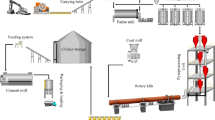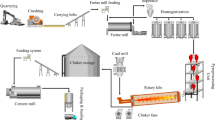Abstract
Nigeria is a leading producer of cement in Africa. Because cement production is energy intensive, with significant adverse impacts on the environment, an apparent need exists to assess the Nigerian cement industry to identify energy use mitigation options. The potentials for reducing energy use in typical Nigerian cement manufacturing plants, through the implementation of available energy efficiency measures, were assessed in this study, alongside the attendant costs of implementing those measures. To achieve these, using numerous globally available energy efficiency technologies and measures, energy conservation supply curves were constructed for three Nigerian cement manufacturing plants which operate on wet, semi-wet, and dry cement manufacturing processes, respectively. Comparisons with global best and Chinese benchmark plants with respect to thermal and electrical energy consumption were also made. The comparisons showed that, with respect to the global benchmark plants, thermal energy savings of between 19.83 and 52%, and electrical energy savings of between 35.23 and 43.10%, were possible. With respect to the Chinese benchmarks, thermal energy savings of 10.74–47.32%, and electrical energy savings of 20.95–30.17%, could be achieved. The plants considered performed significantly less than either of the benchmarks in terms of both thermal and electrical energy usage. The energy conservation supply curves for the plants showed that implementing the cost-effective energy efficiency measures could lead to energy savings of about 235,038, 237,913 and 374,055 GJ/year, for the wet, semi-wet, and dry cement manufacturing plants, respectively. Furthermore, technically feasible efficiency measures could yield energy savings of about 250,272, 259,795 and 395,447 GJ/year, respectively. Achieving these savings will improve profitability in the Nigerian cement industry and make the unused energies available for utilization in other sectors of the Nigerian economy.










Similar content being viewed by others
References
Aithnard PH (2014) Middle Africa’s cement sector: explosive growth. Middle Africa insight series Commodities Cement. http://www.ecobank.com/upload/20140724011129637822cPHHGNvnw6.pdf. Accessed 28 Sept 2016
Bafuwa BO (2015) Carbon footprint reduction opportunities in Portland cement manufacturing processes in Nigeria. M.Eng. project report, Department of Mechanical Engineering, University of Nigeria, Nsukka, Nigeria
Bogan CE, English MJ (1994) LLC benchmarking for best practices: winning through innovative adaptation. McGraw-Hill, New York
Brunke JC, Blesl M (2014) Energy conservation measures for the German cement industry and their ability to compensate for rising energy-related production costs. J Clean Prod 82:94–111
Chatziaras N, Psomopoulos CS, Themelis NJ (2016) Use of waste derived fuels in cement industry: a review. Manag Environ Qual: Int J 27(2):178–193
Engin T, Ari V (2005) Energy auditing and recovery for dry type cement rotary kiln systems-a case study. Energy Convers Manag 46:551–562
Fadare DA, Bamiro AO, Oni AO (2010) Energy and cost analysis of organic fertilizer production in Nigeria. Energy 35:332–340
Fleiter T, Hagemann M, Hirzel S, Eichhammer W, Wietschel M (2009) Costs and potentials of energy savings in european industry – a critical assessment of the concept of conservation supply curves. ECEEE Summer Study, act! Innovate! Deliver! Reducing Energy Demand Sustainably
Galitsky C, Price L, Zhou N, Fuqiu Z, Huawen X, Xuemin Z, Lan W(2008) Guidebook for Using the Tool BEST Cement: Benchmarking and Energy Savings Tool for the Cement Industry. Lawrence Berkeley National Laboratory, Environmental and Energy Technologies Division, Berkeley, CA, USA
Hasanbeigi A, Price L, Lu H, Lan W (2010) Analysis of energy-efficiency opportunities for the cement industry in Shandong province, China: A case study of 16 cement plants. Energy 35:3461–3473
Hasanbeigi A, Price L, Lin E (2012) Emerging energy-efficiency and \(\text{CO}_2\) emission-reduction technologies for cement and concrete production. Technical report, Lawrence Berkeley National Laboratory, China Energy Group, Energy Analysis and Environmental Impacts Department Environmental Energy Technologies Division
Hasanbeigi A, Morrow W, Masanet E, Sathaye J, Xu T (2013) Energy efficiency improvement and CO2 emission reduction opportunities in the cement industry in China. Energy Policy 57:287–297
Huntzinger DN, Eatmon DT (2009) A life-cycle assessment of Portland cement manufacturing: comparing the traditional process with alternative technologies. J Clean Prod 17:668–675
Madlool NA, Saidur R, Hossain MS, Rahim NA (2011) A critical review on energy use and savings in the cement industries. Renew Sust Energy Rev 15:2042–2060
Morrow WR III, Hasanbeigi A, Sathaye J, Xu T (2014) Assessment of energy efficiency improvement and CO2 emission reduction potentials in India’s cement and iron and steel industries. J Clean Prod 65:131–141
Ohunakin O, Leramo O, Abidakun O, Odunfa M, Bafuwa O (2013) Energy and cost analysis of cement production using the wet and dry process in Nigeria. Energy Power Eng 5(9):537–550. doi:10.4236/epe.2013.59059
Osagie C, Chima O (2013) Nigeria upstages South Arica in cement production. Thisday newspaper.www.thisdaynewspaper.com/articles/nigeria-upstages-south-africa-in-cement-production/165241/
Price L, Hasanbeigi A, Lu H, Lu W (2009) Analysis of energy-efficiency opportunities for the cement industry in Shandong province, China. Technical report, Environmental Energy Technologies Division Lawrence Berkeley National Laboratory, Berkeley, CA
Ruth M, Worrell E, Price L (2001) A process-step benchmarking approach to energy use at industrial facilities: examples from the iron and steel and cement industries. In: ACEEE Summer Study on Energy Efficiency in Industry, vol 1, Increasing Productivity Through Energy Efficiency, pp 149–160
Sathaye J, Xu T, Galitsky C (2010) Bottom-up representation of industrial energy efficiency technologies in integrated assessment models for the cement sector. Technical report, Environmental Energy Technologies Division Lawrence Berkeley National Laboratory, Berkeley, CA
Schneider M (2015) Process technology for efficient and sustainable cement production. Cem Concr Res 78:14–23
Tennis PD, Thomas MDA, Weiss WJ (2011) State-of-the-art report on use of limestone in cements at levels of up to 15%. Technical report, Portland Cement Association, Skokie, Illinois
Tesema G, Worrell E (2015) Energy efficiency improvement potentials for the cement industry in Ethiopia. Energy 93:2042–2052
Worrell E, Martin N, Price L (2000) Potential for energy efficiency improvement in the US cement industry. Energy 25:1189–1214
Worrell E, Hendriks C, Price L, Martin N, Meida OL (2001) Carbon dioxide emissions from the global cement industry. Energy Environ 26:303–309
Xu T, Sathaye J, Kramer K (2013) Sustainability options in pulp and paper making: costs of conserved energy and carbon reduction in the US. Sust Cities Soc 8:56–62
Zhang S, Worrell E, Crijns-Graus W (2015a) Cutting air pollution by improving energy efficiency of China’s cement industry. Energy Procedia 83:10–20 In: 7th international conference on sustainability in energy and buildings
Zhang S, Worrell E, Crijns-Graus W (2015b) Evaluating co-benefits of energy efficiency and air pollution abatement in China’s cement industry. Appl Energy 147:192–213
Author information
Authors and Affiliations
Corresponding author
Rights and permissions
About this article
Cite this article
Njoku, H.O., Bafuwa, O.R., Mgbemene, C.A. et al. Benchmarking energy utilization in cement manufacturing processes in Nigeria and estimation of savings opportunities. Clean Techn Environ Policy 19, 1639–1653 (2017). https://doi.org/10.1007/s10098-017-1353-x
Received:
Accepted:
Published:
Issue Date:
DOI: https://doi.org/10.1007/s10098-017-1353-x




